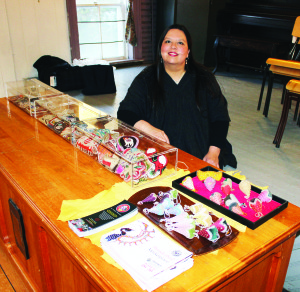|
This page was exported from Caledon Citizen
[ https://caledoncitizen.com ] Export date: Fri Jun 20 19:34:18 2025 / +0000 GMT |
Beadwork assisted native economy in the pastBy Bill Rea Glass beads were introduced to North America by European settlers, but they became very useful in maintain the First Nations economy. Native artisan and educator Naomi Smith recently addressed the annual general meeting of the Belfountain Heritage Society, sharing her love of the artistry that went into many creations, as well as facts about their economic significance. Smith called it “one of my favourite topics.” The colourful glass beads did not originate on these shores. Smith said they were brought over from Europe, and traded with native people. “It's not hard to see why they were so captivating to our ancestors,” she remarked. She also pointed out that many of the beads from those days were very small, and they are seldom made in such sizes any more. Smith had photographs of beaded creations dating back, it's believed, to around the 1820s. She stressed it's always nice to have some piece of documentation to go with a creation, so she was happy to show a picture of some work that could be verified as being made in 1837. The use of geometric designs in such beadwork was common, but Smith pointed out they got more complicated as time went on. She showed some examples in which little pieces of silk were placed around the beads. “This took quite a large amount of time to create,” she remarked. This creativity became popular in the design of bags and purses, and Smith had several pictures of examples. “If only bags could talk,” she remarked. Smith commented that around the 1840s and ‘50s, floral designs became more common in the beadwork, and she said there was a reason for that. Native women at the time would cater to the Victorian market and types of women who would be buying purses in those days. Progressing into the 20th century, Smith said there would have been more use of larger beads. She explained the Edwardian tastes were a little more simple. And it wasn't just purses and bags that were created. Smith had pictures of calling-card cases and pin cushions, which would have played an important role in a Victorian home, as well as match holders, picture frames, etc. There was also a tourist market for this kind of beadwork, with lots of business being conducted in such areas as Niagara Falls. But Smith said the tourist demand for this type of artistry started to slow down around the middle of the 20th century. Smith told the audience that beads were always part of the native culture. Prior to the glass beads from Europe, people made use of beads made from shells, bones, etc. She also pointed out beadwork has been critical to the culture of the cottage industry, as well as being a source of income. “We are traditionally a trading culture,” she remarked. |
|
Post date: 2014-05-07 16:08:12 Post date GMT: 2014-05-07 20:08:12 Post modified date: 2014-05-07 16:08:12 Post modified date GMT: 2014-05-07 20:08:12 |
| Powered by [ Universal Post Manager ] plugin. HTML saving format developed by gVectors Team www.gVectors.com |
